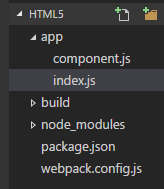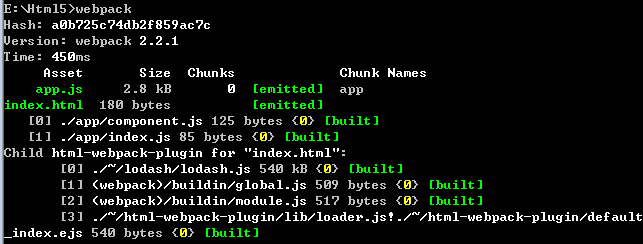webpack入门与解析(一)
1.初始化
npm init -y
这个命令会创建一个默认的package.json。它包含了项目的一些配置参数,通过它可以进行初始安装。详细参数:https://docs.npmjs.com/files/package.json。
不要y参数的话,会在命令框中设置各项参数,但觉得没啥必要。
2.安装webpack
npm install webpack --save-dev
3.目录结构

export default function () {
var element = document.createElement('h1');
element.innerHTML = 'Hello world';
return element;
}
component.js 是输出一个内容为h1元素。export default 是ES6语法,表示指定默认输出。import的时候不用带大括号。
import component from './component';
document.body.appendChild(component());
index.js 的作用就是引用Component模块,并在页面上输出一个h1元素。但完成这个还需要一个插件,因为目前我们还没有index.html文件。
npm install html-webpack-plugin --save-dev
4.设置 webpack 配置文件
const path = require('path');
const HtmlWebpackPlugin = require('html-webpack-plugin');
const PATHS = {
app: path.join(__dirname, 'app'),
build: path.join(__dirname, 'build'),
};
module.exports = {
entry: {
app: PATHS.app,
},
output: {
path: PATHS.build,
filename: '[name].js',
},
plugins: [
new HtmlWebpackPlugin({
title: 'Webpack demo',
}),
],
};
第一次看到这个配置文件是有点懵,主要是exports,分三个部分,一个入口,一个输出,一个插件。入口指向了app文件夹。默认会把包含"index.js"的文件作为入口。输出指定了build地址和一个文件名;[name]这儿表示占位符,可以看成webpack提供的一个变量。这个具体后面再看。而HtmlWebpackPlugin会生成一个默认的html文件。
5.打包

这个输出包含了Hash(每次打包值都不同),Version,Time(耗时)。以及输出的文件信息。 这时打开build文件夹,发现多了一个app.js和index.html文件,双击index.html:

{
"name": "Html5",
"version": "1.0.0",
"description": "",
"main": "index.js",
"scripts": {
"build": "webpack"
},
"keywords": [],
"author": "",
"license": "ISC",
"devDependencies": {
"html-webpack-plugin": "^2.28.0",
"webpack": "^2.2.1"
}
}
指定build。在cmd中执行npm run build 得到同样的结果

<!DOCTYPE html>
<html>
<head>
<meta charset="UTF-8">
<title>Webpack demo</title>
</head>
<body>
<script type="text/javascript" src="app.js"></script></body>
</html>
默认引用了app.js。
6、解析
app.js
/******/ (function(modules) { // webpackBootstrap
/******/ // The module cache
/******/ var installedModules = {};
/******/ // The require function
/******/ function __webpack_require__(moduleId) {
/******/ // Check if module is in cache
/******/ if(installedModules[moduleId])
/******/ return installedModules[moduleId].exports;
/******/ // Create a new module (and put it into the cache)
/******/ var module = installedModules[moduleId] = {
/******/ i: moduleId,
/******/ l: false,
/******/ exports: {}
/******/ };
/******/ // Execute the module function
/******/ modules[moduleId].call(module.exports, module, module.exports, __webpack_require__);
/******/ // Flag the module as loaded
/******/ module.l = true;
/******/ // Return the exports of the module
/******/ return module.exports;
/******/ }
/******/ // expose the modules object (__webpack_modules__)
/******/ __webpack_require__.m = modules;
/******/ // expose the module cache
/******/ __webpack_require__.c = installedModules;
/******/ // identity function for calling harmony imports with the correct context
/******/ __webpack_require__.i = function(value) { return value; };
/******/ // define getter function for harmony exports
/******/ __webpack_require__.d = function(exports, name, getter) {
/******/ if(!__webpack_require__.o(exports, name)) {
/******/ Object.defineProperty(exports, name, {
/******/ configurable: false,
/******/ enumerable: true,
/******/ get: getter
/******/ });
/******/ }
/******/ };
/******/ // getDefaultExport function for compatibility with non-harmony modules
/******/ __webpack_require__.n = function(module) {
/******/ var getter = module && module.__esModule ?
/******/ function getDefault() { return module['default']; } :
/******/ function getModuleExports() { return module; };
/******/ __webpack_require__.d(getter, 'a', getter);
/******/ return getter;
/******/ };
/******/ // Object.prototype.hasOwnProperty.call
/******/ __webpack_require__.o = function(object, property) { return Object.prototype.hasOwnProperty.call(object, property); };
/******/ // __webpack_public_path__
/******/ __webpack_require__.p = "";
/******/ // Load entry module and return exports
/******/ return __webpack_require__(__webpack_require__.s = 1);
/******/ })
/************************************************************************/
/******/ ([
/* 0 */
/***/ (function(module, __webpack_exports__, __webpack_require__) {
"use strict";
/* harmony default export */ __webpack_exports__["a"] = function () {
var element = document.createElement('h1');
element.innerHTML = 'Hello world';
return element;
};
/***/ }),
/* 1 */
/***/ (function(module, __webpack_exports__, __webpack_require__) {
"use strict";
Object.defineProperty(__webpack_exports__, "__esModule", { value: true });
/* harmony import */ var __WEBPACK_IMPORTED_MODULE_0__component__ = __webpack_require__(0);
document.body.appendChild(__webpack_require__.i(__WEBPACK_IMPORTED_MODULE_0__component__["a" /* default */])());
/***/ })
/******/ ]);
而app.js内容比较多了。整体是一个匿名函数。
(function(module) {
})([(function (){}), function() {}])
app文件夹中的两个js文件成了这儿的两个模块。函数最开始是从__webpack_require__开始
return __webpack_require__(__webpack_require__.s = 1);
这里指定从模块1执行(赋值语句的返回值为其值)。而模块1的调用是通过__webpack_require__的这句执行的。
modules[moduleId].call(module.exports, module, module.exports, __webpack_require__);
通过call调用模块的主要作用是为了把参数传过去。
(function(module, __webpack_exports__, __webpack_require__) {
"use strict";
Object.defineProperty(__webpack_exports__, "__esModule", { value: true });
/* harmony import */ var __WEBPACK_IMPORTED_MODULE_0__component__ = __webpack_require__(0);
document.body.appendChild(__webpack_require__.i(__WEBPACK_IMPORTED_MODULE_0__component__["a" /* default */])());
/***/ })
__webpack_require__ 每加载一个模块都会先去模块缓存中找,没有就新建一个module对象:
var module = installedModules[moduleId] = {
i: moduleId,
l: false,
exports: {}
};
模块1中加载了模块0,
var __WEBPACK_IMPORTED_MODULE_0__component__ = __webpack_require__(0);
__WEBPACK_IMPORTED_MODULE_0__component__ 返回的是这个模块0的exports部分。而之前Component.js的默认方法定义成了
__webpack_exports__["a"] = function () {
var element = document.createElement('h1');
element.innerHTML = 'Hello world';
return element;
}
所以再模块1的定义通过"a“来获取这个方法:
document.body.appendChild(__webpack_require__.i(__WEBPACK_IMPORTED_MODULE_0__component__["a" /* default */])());
这样就完整了,但这里使用了__webpack_require__.i 将原值返回。
/******/ // identity function for calling harmony imports with the correct context
/******/ __webpack_require__.i = function(value) { return value; };
不太明白这个i函数有什么作用。这个注释也不太明白,路过的大神希望可以指点下。
小结:
webpack通过一个立即执行的匿名函数将各个开发模块作为参数初始化,每个js文件(module)对应一个编号,每个js中export的方法或者对象有各自指定的关键字。通过这种方式将所有的模块和接口方法管理起来。然后先加载最后的一个模块(应该是引用别的模块的模块),这样进而去触发别的模块的加载,使整个js运行起来。到这基本了解了webpack的功能和部分原理,但略显复杂,且没有感受到有多大的好处。继续探索。
demo:http://files.cnblogs.com/files/stoneniqiu/webpack-ch1.zip 建议用最新的node安装,不然build后的结果可能出错。
参考:
webpack入门与解析(一)的更多相关文章
- webpack入门(1)
webpack入门(1) 源码戳这里 ps:每个案例对应相应的demo,例如"案例1"对应"demo1" 一.webpack基本功能及简单案例 安装webpac ...
- 【webpack2】-- 入门与解析
每次学新东西总感觉自己是不是变笨了,看了几个博客,试着试着就跑不下去,无奈只有去看官方文档. webpack是基于node的.先安装最新的node. 1.初始化 安装node后,新建一个目录,比如ht ...
- webpack入门教程之Hello webpack(一)
webpack入门教程系列为官网Tutorials的个人译文,旨在给予想要学习webpack的小伙伴一个另外的途径.如有不当之处,请大家指出. 看完入门教程系列后,你将会学习到如下内容: 1.如何安装 ...
- webpack入门——webpack的安装与使用
一.简介 1.什么是webpack webpack是近期最火的一款模块加载器兼打包工具,它能把各种资源,例如JS(含JSX).coffee.样式(含less/sass).图片等都作为模块来使用和处理. ...
- 一小时包教会 —— webpack 入门指南
什么是 webpack? webpack是近期最火的一款模块加载器兼打包工具,它能把各种资源,例如JS(含JSX).coffee.样式(含less/sass).图片等都作为模块来使用和处理. 我们可以 ...
- Webpack 入门指南 - 3. Hello, Angular2!
Webpack 入门指南 - 1.安装 Webpack 入门指南 - 2.模块 这一次,我们使用 Webpack 来打包 Angular 2 的应用. 与官方的 Hello, Angular 2 项目 ...
- Webpack 入门指南 - 2.模块
这一次我们谈谈模块问题. 通常我们希望这个项目可以分为多个独立的模块,比如,上一次提高的 hello 函数,如果我们定义为一个模块,其它模块引用之后,直接调用就好了.在前端怎么使用模块呢?这可说来话长 ...
- Webpack 入门指南 - 1.安装
Webpack 是目前流行的打包工具,如何安装它呢? 1. 安装 Node Js 首先,Webpack 是基于 NodeJs 的工具,你必须首先安装 NodeJs. NodeJs 仅仅只需要在你的系统 ...
- webpack入门和实战(一):webpack配置及技巧
一.全面理解webpack 1.什么是 webpack? webpack是近期最火的一款模块加载器兼打包工具,它能把各种资源,例如JS(含JSX).coffee.样式(含less/sass).图片等都 ...
随机推荐
- JDBC连接数据库以及简单的操作
package com.zhiyuan.jdbc.util; import java.sql.Connection;import java.sql.DriverManager;import java. ...
- 前段验证框架 formValidator
http://blog.csdn.net/lorinzhang/article/details/7283557
- bzoj1070————2016——3——14
传送门:http://www.lydsy.com/JudgeOnline/problem.php?id=1070: 题目概括: Description 同一时刻有N位车主带着他们的爱车来到了汽车维修中 ...
- mybatis:"configuration" must match "(properties?,settings?,typeAliase.....
在运行mybatis配置文件的时候,出现错误: mybatis:"configuration" must match "(properties?,settings?,ty ...
- PHP使用GD2库画图,图像无法输出解决方法
在CS6编辑环境下,使用php的GD2库绘制图像,在浏览器上输出可能会出现图像无法输出的情况,目前发现两个解决方法:方法1:用记事本写,再另存为utf-8 no bom的格式. 方法2:在代码中添加o ...
- cpsr当前程序状态寄存器
详解CPSR寄存器(ls_core) (2012-10-11 17:29:47) 转载▼ 标签: arm920t寄存器 cpsr cpu工作原理 分类: 第四章-踏入嵌入式领域之ARM 在介绍CPSR ...
- EhLib DBGridEh组件在Delphi中应用全攻略总结(转)
EhLib DBGridEh组件在Delphi中应用全攻略总结(转) http://blog.sina.com.cn/s/blog_94b1b40001013xn0.html 优化SQL查询:如何写出 ...
- 【翻译】使用Visual Studio在Azure上部署Asp.Net Core Web应用
配置运行环境 Install the latest Azure SDK for Visual Studio. The SDK installs Visual Studio if you don't a ...
- Swift之UITabBarController 导航控制器颜色的改变
废话不多 直接上代码 self.window = UIWindow(frame: UIScreen.mainScreen().bounds) self.window!.backgroundColor ...
- underscore 1.7.0 api
它是这个问题的答案:“如果我在一个空白的HTML页面前坐下, 并希望立即开始工作, 我需要什么?“ http://www.css88.com/doc/underscore/#
